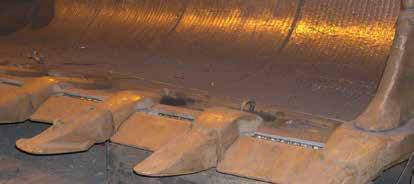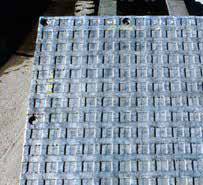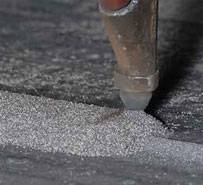
ULTRA-MET® - PREMIUM CHROMIUM CARBIDE OVERLAY PLATE
ULTRA-MET®
Ultra-Met is a premium grade, permanently-bonded chromium carbide overlay plate made for the most severe abrasive wear environments. Ultra-Met is a composite material of ultra-hard, chromium carbide crystals micro-embedded in a resilient alloy matrix. Ultra-Met’s extreme hardness, toughness and heat resistance has been industry proven to outlast almost all other materials.
All Ultra-Met Hardfacing Overlay grades are produced to rigid specifications in our North American facility under strict process controls. The submerged arc welding process produces a permanently bonded, resilient overlay that resists to chipping or spalling. The result is a surface possessing an excellent combination of high resistance to erosion, severe abrasion and moderate impact strength. Our proprietary chemistry yields a superior overlay plate. Ultra-Met has exhibited wear resistance up to 20 times that of mild steel.
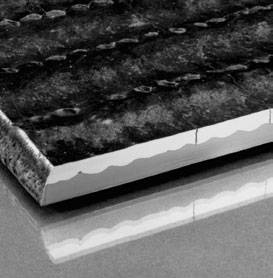
AVAILABLE STOCK SIZES (48″ X 120″ PLATES)
| Layers | Hardfacing | Base | Nominal Thickness |
|---|---|---|---|
| Single | 3/16″ | 3/16″ | 3/8″ |
| Single | 1/8″ | 1/4″ | 3/8″ |
| Single | 1/4″ | 1/4″ | 1/2″ |
| Single | 1/4″ | 1/2″ | 3/4″ |
| Double | 3/16″+ 3/16″ | 3/8″ | 3/4″ |
| Single | 1/4″ | 3/4″ | 1″ |
| Double | 1/4″+ 1/4″ | 1/2″ | 1″ |
HARDFACING ADVANTAGES
- Outlasts AR steels by an average of 4 to 6 times
- Quick payback
- Maximum resistance to abrasion
- Superior resistance to chipping, peeling or separation
- Made in U.S.A.
- Many thickness combinations
- Abrasion resistant properties up to 1,250°F. (676°C).
- Multiple grades
INITIAL PRICE VS. LIFETIME COST
The real cost of abrasion-resistant steels (AR400, AR500) can be over 50% higher than Ultra-Met. In proper applications, Ultra-Met outlasts other steels, including heat-treated wear-resistant alloys, by an average of four to six times. Payback occurs quickly—with the third replacement of the lower resistant AR material.
hardfacing SERVICE LIFE COMPARISONS
| Grade | Compared to Carbon Steel | Compared to Heat Treated AR-Steels |
|---|---|---|
| Standard | 20-25 to 1 | 4-6x |
| Severe Abrasion | 25-30 to 1 | 5-7x |
Ultra-Met can outperform AR steels by a much as 20 times in certain applications, such as in the glass plant application. Talk with a St. Lawrence specialist to determine how Ultra-Met can outlast AR steel for your specific needs.
WEIGHT REDUCTION


ULTRA-MET HARDFACING CHEMISTRY (TYPICAL %)
| Grade | Cr | C | Ni | Mn |
|---|---|---|---|---|
| Standard | 23 - 32% | 3.5 - 4.2% | 0.2%* | 1.0%* |
| Abrasion | 32 - 36% | 4.5 - 6.0% | 0.2%* | 1.5%* |
STEEL PLATE COMPARISON
| Product | Abrasion Resistance | Impact Resistance | Weldability | Machinability | Forming | Cutting |
|---|---|---|---|---|---|---|
| MAN-CRO 400F | G | VG | VG | F | G | VG |
| MAN-CRO 450F | G - VG | G | G | M - F | F - G | G - VG |
| MAN-CRO 500F | VG | F | F | M | F | G |
| AR-Max | VG | VG | VG | F | G | VG |
| Ultra-Met Standard | E | G | E(1) | M(2) | F | G(4) |
| Ultra-Met Impact | VG | G - VG | E(1) | M(2) | M - F | G(4) |
| Ultra-Met Abrasion | E - S | G | E(1) | M(2) | F | G(4) |
| Hardlite | E | G | E(1) | M(2) | F | G(4) |
| SLS 14% Manganese | F | E | VG(3) | M | G | G |
S: Superior, E: Excellent, VG: Very Good, G: Good, F: Fair, M: Marginal
(1) Carbon Base Only
(2) EDM, Plasma or Air Arc holes only
(3) When welding Manganese to any other metal, use 309 or 310 SS electrode w/ minimum heat input
(4) Plasma, waterjet, or laser
HARDNESS COMPARISON
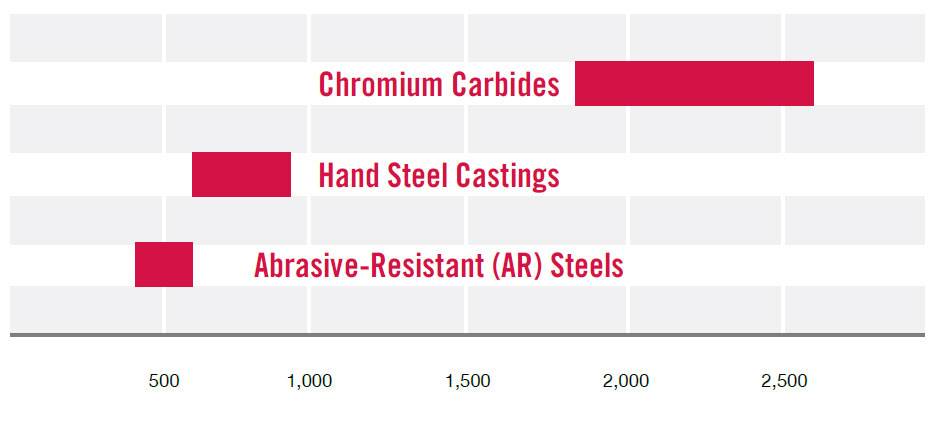
Vickers Hardness (HV)
Chromium Carbides 1,750-2,500 HV
Hard Steel Castings 585-845 HV
Abrasive-Resistant (AR) Steels 380-540 HV
MECHANICAL PROPERTIES (TYPICAL)
| Grades | Surface Hardness | ASTM G-65 Mass Loss | Carbide Hardness (Max.) |
|---|---|---|---|
| Standard | 56-62 Rc | .195-.235 g | 1750 HV |
| Abrasion | 60-62 Rc | .175 g | 1750 HV |
| Impact | 49-55 Rc | .510 g | — |
MICROSTRUCTURE
The microstructure of Ultra-Met (shown at 200x magnification) is a high density of chrome carbide crystals in a tough alloy matrix. In Ultra-Met, the chrome carbide crystals act like the stones in concrete. As the concrete pavement wears, the stones provide a surface that resists abrasion better than the cement in which they are embedded. The hardfacing chrome carbides in Ultra-Met serve the same purpose, providing an ultra-hard microstructure that resists wear longer than the alloy steel around them.
The strictly controlled submerged arc process used to produce Ultra-Met creates a greater density of chrome carbides, resulting in outstanding abrasion resistance.
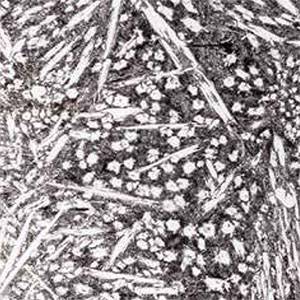
FABRICATION
We recommend the use of St. Lawrence’s fabrication services to eliminate processing and fabrication errors.
CUTTING
Ultra-Met can be cut with water jet, plasma burning equipment, air arc or abrasive saws. The minimum recommended plate temperature should be +60° F during processing. Ultra-Met can be field pierced with covered metal electrodes; Chamfer-Trode, Rocket Groove, Cut-Trode or equivalents.
GOUGING (CARBON ARC)
A conventional constant current DC welding supply 80V is recommended for gouging. Gouging should occur from the base metal side of the Ultra-Met plate. Remove slag with a grinding disc.
SAWING
Although a slow process, cutting can be achieved using an abrasive silicon carbide wheel.
FORMING
Ultra-Met can be formed to a radius of not less than 20 times the thickness using a press brake or rolls. If using rolls, it is recommended that a 10 ga. sheet of mild steel be placed on top of the Ultra-Met to prevent nicking the surface of the forming rolls. It is recommended that plates be rolled in the direction of the overlay weld beads. Forming will either increase or decrease the width of the stress relief cracks in the overlay. This result should be expected and should not adversely affect the performance of the chromium carbide overlay fabrication if the radius recommendations are followed.
MACHINING
Shearing, punching or machining is not recommended. Ultra-Met can be efficiently blanchard ground. A magnetic table will hold base metal, but Ultra-Met is non-magnetic, so if base is to be ground, also, use mechanical means to hold the plate.
REPAIRING
Repair of chromium carbide overlay surface can be achieved using a manual arc welding process. St. Lawrence PN 200-W-ACF hard surface wire is recommended. Additional cracks may be noticeable, but will not affect abrasion resistance.
GRINDING
Ultra-Met can be abrasive ground with a hard grit, soft bond stone.
WELDING
Welding of Ultra-Met chromium carbide overlay can be accomplished by the joining of the carbon steel base material using any low hydrogen weld rod or wire. Care should be used not to dilute the Ultra-Met surface into the joint. This could cause cracking and premature failure. When welding two pieces of Ultra-Met, bevel the base plate (underside) and complete using normal welding procedures.
